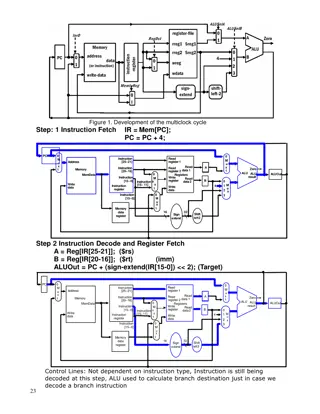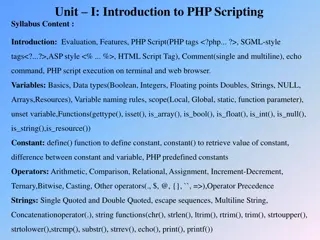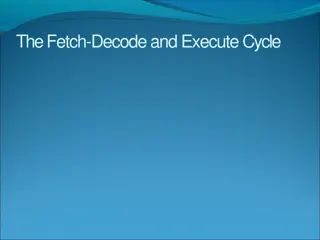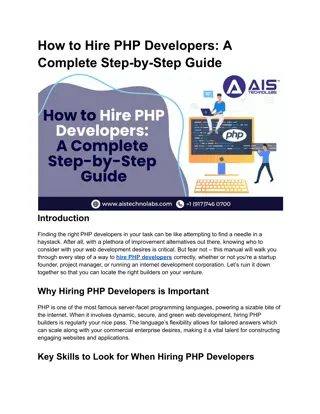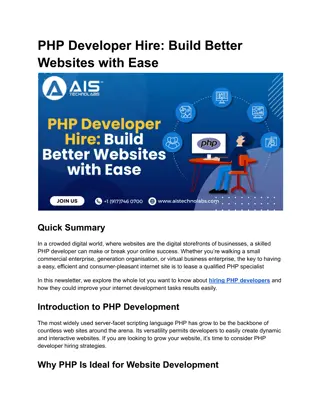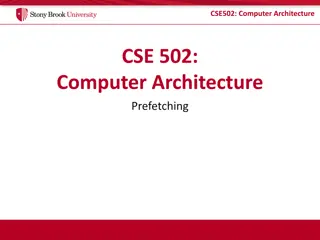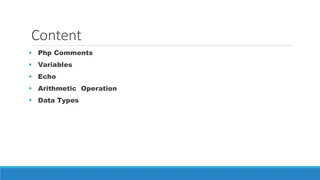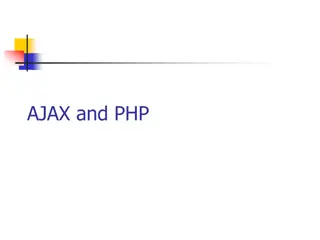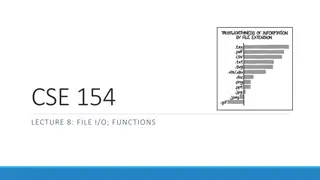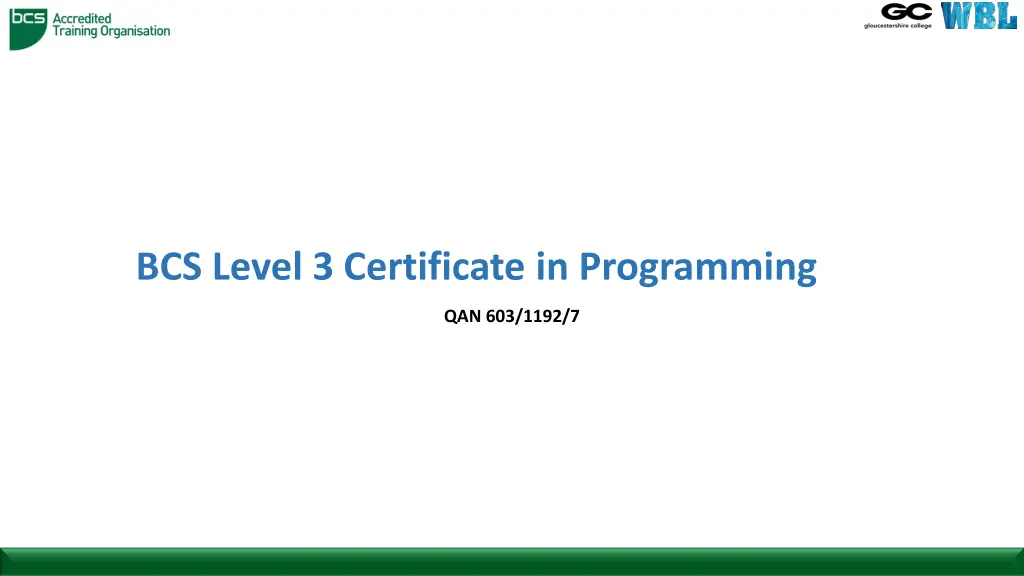
BCS Level 3 Certificate in Programming Syllabus and Exam Details
"Explore the syllabus and examination details of the BCS Level 3 Certificate in Programming, including areas like software development, coding practices, interface design, and security software. Prepare for the exam with targeted questions and learning outcomes. Understand procedural, object-oriented, and functional programming concepts in this comprehensive certification program."
Download Presentation

Please find below an Image/Link to download the presentation.
The content on the website is provided AS IS for your information and personal use only. It may not be sold, licensed, or shared on other websites without obtaining consent from the author. If you encounter any issues during the download, it is possible that the publisher has removed the file from their server.
You are allowed to download the files provided on this website for personal or commercial use, subject to the condition that they are used lawfully. All files are the property of their respective owners.
The content on the website is provided AS IS for your information and personal use only. It may not be sold, licensed, or shared on other websites without obtaining consent from the author.
E N D
Presentation Transcript
BCS Level 3 Certificate in Programming QAN 603/1192/7
Syllabus For each top-level area of the syllabus a percentage and K (knowledge) level is identified. The percentage shown relates to the proportion of the exam given to that area. The K level identifies the maximum knowledge level that may be tested for that area. K1 Remember and follow K2 Understand and assist K3 Apply
Syllabus Implementing software code following a logical approach (17.5%, K3 Apply) How code integrates into the wider project (10%, K2 Understand and assist) Developing software against a set of functional and non-functional requirements (15%, K2 Understand and assist) The end user context for software development (7.5%, K2 Understand and assist) Connecting code to data sources (5%, K2) Database normalisation (5%, K3 Apply) Following good coding practices (12.5%, K2 Understand and assist) Principles of good interface design (10%, K2 Understand and assist) Building in security software (17.5%, K2 Understand and assist)
Examination (pass mark 26/40, multiple choice, 1 hour) Syllabus Area Target number of questions 1. Implementing software code following a logical approach 7 2. How code integrates into the wider project 7 3. Developing software against a set of functional and non- functional requirements 6 4. The end-user context for software development 3 5. Connecting code to data sources 3 6. Database normalisation 2 7. Following good coding practices 3 8. Principles of good interface design 4 9. Building in security software 5 Total 40
Implementing software code following a logical approach (17.5%, K3) Fundamentals of programming Constructs Algorithms Data structures Problem solving Test driven development (TDD)
Learning outcomes 1. Understand how to implement code, following a logical approach (17.5%, K3) a) 1.1. Fundamentals of Programming b) 1.2. Core constructs used when writing code
Procedural vs. object-oriented vs. functional programming Programs are made up of modules These are parts of a program that can be coded and tested separately Assembled to form a complete program The design method used in procedural programming is called Top Down Design Top Down Design (TDD)
Procedural vs. object-oriented vs. functional programming An alternative to procedural programming is object oriented programming. Object oriented programming is meant to address the difficulties with procedural programming. In object oriented programming, the main modules in a program are classes, rather than procedures. The object-oriented approach lets you create classes and objects that model real world objects.
Procedural vs. object-oriented vs. functional programming Object-oriented Programming uses data fields where Procedural Programming uses procedures Procedural Object-oriented Procedure Method Record Object Module Class Procedure call Message
Procedural vs. object-oriented vs. functional programming Functional programming languages are specially designed to handle symbolic computation and list processing applications Based on mathematical functions Popular functional programming languages include: Lisp, Python, Erlang, Haskell, Clojure, etc. Two categories: Pure functional languages support only the functional paradigms - Haskell Impure functional languages support the functional paradigms and imperative style programming - Lisp
Procedural vs. object-oriented vs. functional programming Functional Programming OOP Uses Immutable data. Uses Mutable data. Follows Declarative Programming Model. Follows Imperative Programming Model. Focus is on: What you are doing Focus is on How you are doing Supports Parallel Programming Not suitable for Parallel Programming Its methods can produce serious side effects. Its functions have no-side effects Flow Control is done using function calls & function calls with recursion Flow control is done using loops and conditional statements. It uses "Loop" concept to iterate Collection Data. For example: For-each loop in Java It uses "Recursion" concept to iterate Collection Data. Execution order of statements is not so important. Execution order of statements is very important. Supports both "Abstraction over Data" and "Abstraction over Behavior". Supports only "Abstraction over Data".
Compiled vs. interpreted A compiled language is one where the program, once compiled, is expressed in the instructions of the target machine. E.G. an addition "+" operation in your source code could be translated directly to the "ADD" instruction in machine code. An interpreted language is one where the instructions are not directly executed by the target machine, but instead read and executed by some other program, the interpreter. COMPILED INTERPRETED
Compiled Languages C Pascal C++ Scala C# - to bytecode (CIL) Swift Erlang to bytecode Smalltalk Objective-C TypeScript Java to bytecode AppleScript to bytecode
Interpreted Languages JavaScript Python PHP Perl Excel VBScript Matlab PowerShell
Core constructs Classes Objects Methods Variables Logic operators
Classes A class describes data It defines the abstract characteristics of an object very much like a blueprint A class is an entity that defines how an object will behave and what the object will contain when the object is constructed, or instantiated Things it can do Methods Attributes - Properties and fields
Objects An object can be a variable, a data structure, a function, or a method, and as such, is a value in memory referenced by an identifier. In the class-based object-oriented programming paradigm, object refers to a particular instance of a class, where the object can be a combination of variables, functions, and data structures.
Methods A method in object-oriented programming is a procedure associated with a class A method defines the behaviour of the objects that are created from the class Another way to say this is that a method is an action that an object is able to perform The association between method and class is called binding
Variables In OOP there are two types of variables: a variable defined in a class of which a single copy exists, regardless of how many instances of the class exist class variables a variable that has been allocated "statically", meaning that its lifetime (or "extent") is the entire run of the program static variables
Logic Operators Computers make use of logic gates to perform operations. While there are only three logic operators to consider when programming, there are others that could be used programmatically.
Logic Operators Logic operators allow a program to make a decision based on multiple conditions Each operand is considered a condition that can be evaluated to a true or false value Logic operators have precedence in the same way as normal mathematical operators
Logic Operators Function Java && C# && VB.net AND AND Performs a logical AND operation: A && B Performs a logical AND operation: A || B Performs a logical NOT operation: A != B OR || || OR NOT ! ! NOT
Control structures Flow of control through any given function is implemented with three basic types of control structures: Sequential: default mode. Selection: used for decisions, branching - choosing between 2 or more alternative paths. Repetition: used for looping, i.e. repeating a piece of code multiple times in a row.
Sequential Each statement in the source code will be executed one by one in a sequential order It is written for a single thread This is the default mode of execution Dim ctr1, ctr2 As Integer For ctr2 = 1 to 5 Next End Sub 'Display first 10 multiples For ctr1 = 1 to 10 Next System.Console.WriteLine(1 & "*" & ctr1 & "+" & (1 * ctr1)
Selection The selection control structure is used for making decisions and branching statements The following are the basic selection statements in the programming language: If If-else Switch case
IF Statements Used to make decisions in your programming code. Good for complicated tests Comparisons Logic checks Multiple checks Nested checks ? etc
If Statements Example Test if x = 5 or x = 10 If variableA = variableB If x > 5 If x <> 22 And so on The If is called a selection statement since it can select alternative paths through the program.
IF Else Statements A decision statement such as if can choose to take one path else take another. Example: If x > 10 then 'Statements Else 'do something else End If
IF IfElseElse statements A decision statement such as if can choose to take one path else take another, but you have situations where a number of conditions need to be checked to decide which statements to run. Example: if x > 10 then elseif x > 5 then elseif else end if if x > 10 then 'Statements elseif x > 5 then 'do these elseif x > 3 Then 'do these else 'do these end if 'Statements 'do these x > 3 Then 'do these 'do these
Programming Task Create a new GUI program using Visual Studio. We are going to use a new feature for this program called the message box. The Message box is called a dialogue window since it displays in a small window allow the user to respond to the message. Let s try this out. Once you have a blank form showing, double click on the form to go to the form load code stub, we are not adding controls to this program.
Programming Task In the Form1_load code stub enter this code then run it. Dim Mark as Integer Mark = InputBox( Enter an exam mark from 0 to 100 ) If Mark >= 60 then MessageBox.Show( Merit ) ElseIf Mark >= 40 Then MessageBox.Show( Pass ) Else MessageBox.Show( A mark of + Mark.tostring + is a fail ) End if
IF IfElseElse Statements Many If else statements can make your code look messy and perform poorly. Is there a better way? You will be pleased to know that there is.
The Select Case Statement The select case statement makes it easy to code for multiple ElseIf statements in a more readable and maintainable way. Select Case x Case 19 Case 15 Case Else End Select Do statements Do statements Do statements
Select Case Construct Select . . Case construct allows a large number of results. This is the equivalent of multiple If..ElseIf constructs.
Program Challenge Can you change your program you created earlier to use the Select Case statements rather than the If Elseif statements.
Iteration or Repetition The iterative control structures are used for repetitively executing a block of code multiple times The following are the basic iterative control structures: For While Do-while
For . Next loops Loop continues for specified number of repetitions. These are fixed loops
Do . While loops Loop continues while condition is TRUE This is a pre-check loop, it checks the condition at the start so the code within it may never run Here the condition is at the end, the loop body executes at least once. This is a post check loop
Do . Until Loops Loop continues until condition is true.
End of Session That completes the first part of Implementing software code following a logical approach





